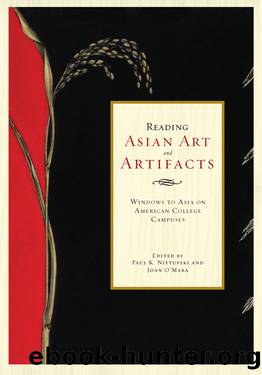Reading Asian Art and Artifacts by unknow

Author:unknow
Language: eng
Format: epub
Publisher: Lehigh University Press
Published: 2011-08-15T00:00:00+00:00
KhedrupjE嫉s Vision of Tsongkhapa:
Windows to the Gelukpa World
The DePauw Tibetan painting of Khedrupjéâs Vision of Tsongkhapa on a Tiger (plate 15) is an excellent example of art as a visible language. It tells many stories and is itself part of a larger story, that of the Tibetan Buddhist synthesis of monasticism, rigorous scholarship, and esoteric meditations. First of all, the painting is one of a set of five showing the five visionary encounters between Khedrupjé (1385â1438) and his late master, Tsongkhapa. The time frame for these visions was the nineteen-year period after Tsongkhapaâs passing in 1419. In this painting, the monk and scholar Tsongkhapa (1357â1419) appears as a tantric adept riding a tiger.
Khedrupjéâs importance as a scholar, an author, and a political leader of the Tibetan Buddhist order cannot be underestimated. His twelve volumes of written works are clear and accessible; they remain authoritative and are closely studied to this day. From 1431 to 1438, he served as the third abbot of Ganden Monastery and helped lay the foundations for the institution of the Dalai Lamas. In the years of Mongol influence in central Tibet, he was retrospectively recognized as the First Panchen lama. Khedrupjé, perhaps inadvertently, played an important role in the ascendance of the Tibetan Buddhist Gelukpa order.30 The historical context of Khedrupjéâs visions is complex, a crucial period in the politics of the Tibetans, Mongols, and Chinese.
The subject matter of the painting tells a story of the Tibetan religious and doctrinal synthesis. Tsongkhapa and his two disciples Khedrupjé and Gyaltsapjé were instrumental in the development of the mainstream Tibetan Buddhist Gelukpa order, which by tradition focused on a synthesis of monasticism, philosophy, and tantrism. All three of these components of Tibetan Buddhism are represented in the DePauw painting.31
On the top left of the painting is the Indian scholar of monasticism, Gunaprabha, one of the âtwo superiorsâ (with Shakyaprabha) whose works are the core canonical monastic documents for all Tibetan Buddhists. The figure at the top center is identified in the DePauw documentation as the Third Panchen Lama Lozang Pelden Yeshé (1738â1780), an important figure in Tibetan and Manchu history. At the top right is the third-century CE Indian philosopher Nagarjuna, author of the core texts of Buddhist Middle Way (Madhyamaka) philosophy. The DePauw data identify the figures in the lower register as, on the left, the important figure Losang Pelden (evidently Longdol Lama Ngakwang Losang, 1719â1794), in red monkâs robes, the tantric protector deity Mahakala, and, on the right, the Indian scholar Asanga, a key figure in the development of âConsciousness Onlyâ philosophy.
The painting instructs the viewer that Buddhist monasticism and Mahayana Buddhist doctrines are parameters for the exercise of tantrism as practiced by the central figure. Moreover, all this takes place in a well-defined historical context, shown by the Third Panchen lama, a scholar in the lineage of Tsongkhapa, with political roots in western Tibet and powerful connections to the Qing court. The vision of Tsongkhapa in the center, though one of five icons of Tsongkhapa
Download
This site does not store any files on its server. We only index and link to content provided by other sites. Please contact the content providers to delete copyright contents if any and email us, we'll remove relevant links or contents immediately.
Make Comics Like the Pros by Greg Pak(2451)
The Social Psychology of Inequality by Unknown(2345)
Stacked Decks by The Rotenberg Collection(2307)
Purple Hibiscus by Chimamanda Ngozi Adichie(2022)
The Art of Doom by Bethesda(1794)
The Queen of Nothing by Holly Black(1791)
Putin's Labyrinth(1676)
The Power of Habit: Why We Do What We Do in Life and Business by Charles Duhigg(1618)
Life of Elizabeth I by Alison Weir(1587)
Drawing Down the Moon by Margot Adler(1495)
Agency by William Gibson(1490)
Wall and Piece by Banksy(1479)
Things Are What You Make of Them: Life Advice for Creatives by Adam J. Kurtz(1465)
The Beatles Lyrics by Hunter Davies(1393)
Only What's Necessary: Charles M. Schulz and the Art of Peanuts by Chip Kidd(1388)
Art Of Atari by Tim Lapetino(1342)
The Andy Warhol Diaries by Andy Warhol(1267)
Uncanny Valley by Anna Wiener(1259)
The Economist (20150926) by calibre(1253)
